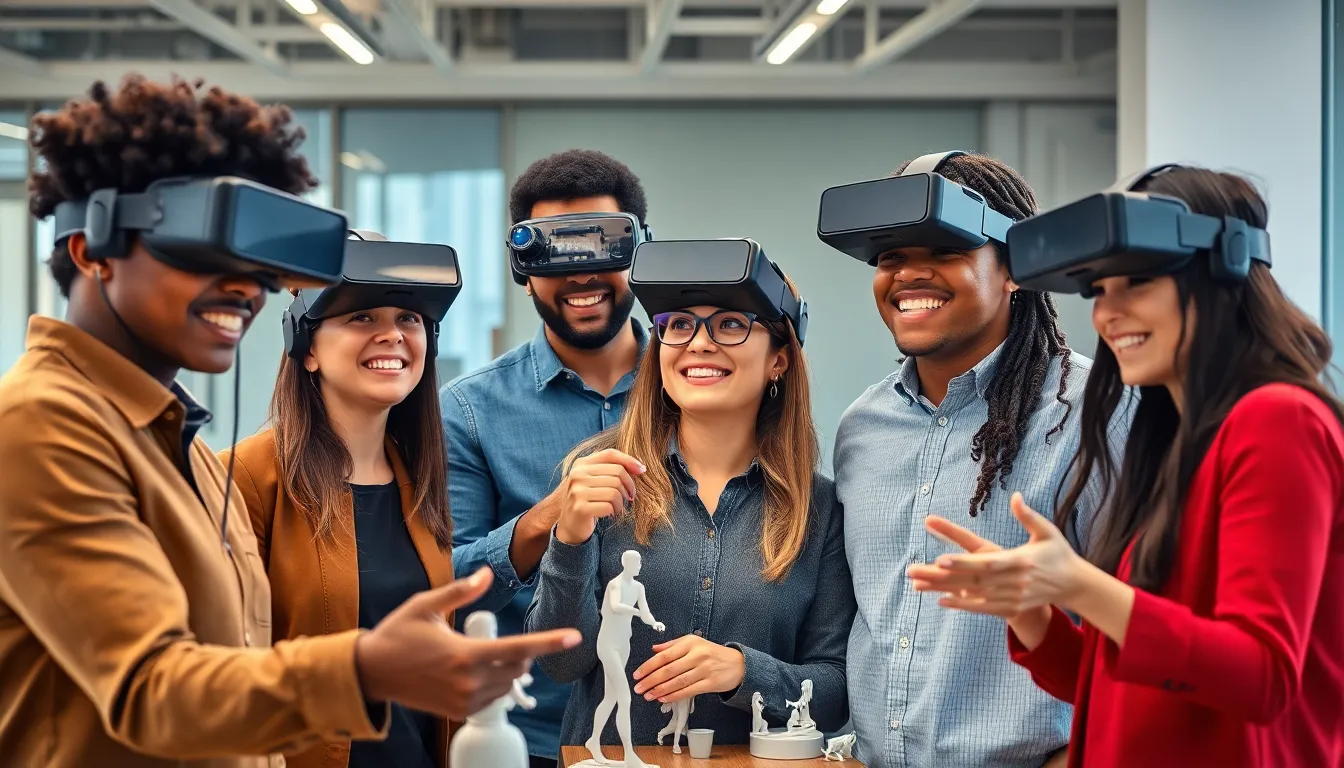Augmented Reality (AR) is transforming the workplace in ways that were once thought to be the realm of science fiction. By overlaying digital information onto the physical world, AR empowers employees to enhance their productivity and collaboration. This innovative technology is not just a tool for entertainment; it’s becoming an essential part of training, remote assistance, and everyday tasks.
As companies embrace AR, they’re discovering its potential to revolutionize employee engagement and streamline operations. From immersive training programs to real-time problem-solving, AR is reshaping how teams interact and learn. In this article, we’ll explore the benefits of AR for employees and how it’s paving the way for a more efficient and dynamic work environment.
Table of Contents
ToggleOverview Of AR For Employees
Augmented Reality (AR) significantly alters how employees interact with their work environment. By integrating digital information into the physical world, AR enhances productivity and collaboration.
Definition Of Augmented Reality
Augmented Reality refers to technology that overlays computer-generated images, sounds, or other data onto the real world. AR enhances the user’s perception of their surroundings, providing contextual information that improves decision-making and task execution. Examples of AR applications include visualization tools that showcase data analytics in real-time and interactive manuals guiding employees through complex procedures.
Importance In the Workplace
AR’s importance in the workplace encompasses several key benefits:
- Training Enhancement: AR facilitates immersive training sessions that engage employees, enabling them to learn complex tasks more efficiently.
- Improved Collaboration: AR fosters collaboration among remote teams by offering shared visual experiences that enhance communication and problem-solving.
- Increased Efficiency: AR reduces the time employees spend searching for information by providing instant access to necessary data, thus streamlining workflows.
- Safety and Maintenance: AR tools guide employees through safety procedures and maintenance tasks, reducing errors and enhancing overall safety protocols.
As AR continues to gain traction, its role in fostering a productive and efficient work environment becomes increasingly critical.
Benefits Of AR For Employees

Augmented Reality (AR) brings significant advantages to employees, enhancing their workflow and collaboration. The technology fosters an engaging work environment that leads to improved productivity and effectiveness.
Enhanced Training And Development
AR provides immersive training experiences that engage employees in a more interactive way.
- Hands-On Learning: Employees practice skills in realistic scenarios, increasing retention rates.
- Immediate Feedback: Workers receive instant assessments during training tasks, allowing them to correct mistakes in real time.
- Cost-Effectiveness: Companies reduce training costs by minimizing the need for physical resources and on-site instructors.
- Access to Expertise: Remote experts can guide employees through complex tasks via AR overlays, enhancing learning opportunities.
Improved Collaboration And Communication
AR revolutionizes teamwork by allowing employees to share visual information seamlessly.
- Shared Experiences: Team members interact with the same AR models, promoting unified understanding.
- Visual Problem-Solving: Graphics overlay real objects, enabling clearer communication of ideas and solutions.
- Remote Connectivity: Teams spread across different locations collaborate in real time, breaking down geographical barriers.
- Efficient Meetings: Visual data presented in AR formats makes discussions more productive, helping expedite decision-making processes.
Implementing AR In the Workplace
Implementing Augmented Reality (AR) in the workplace requires a strategic approach to technology selection and employee training. Organizations must assess their needs and invest in the appropriate tools to maximize the benefits of AR.
Necessary Technology And Tools
Organizations must identify and acquire the technology and tools required for AR implementation. Key components include:
- AR Devices: Invest in AR headsets, smart glasses, or mobile devices capable of displaying AR content.
- Software Platforms: Choose AR software that aligns with specific business objectives, such as training, maintenance, or remote collaboration.
- High-Speed Internet: Ensure reliable internet connectivity to support seamless AR experiences, particularly for real-time data and remote collaboration.
- Integration Systems: Utilize APIs and development kits to integrate AR solutions with existing company systems, enhancing workflow efficiency.
Training Employees To Use AR
- Comprehensive Training Programs: Develop structured training sessions that cover AR basics, device usage, and software functionalities.
- Hands-On Learning: Provide employees with hands-on experiences to familiarize them with AR applications relevant to their roles.
- Ongoing Support: Establish support channels, such as help desks or coaching sessions, to assist employees as they adapt to new technologies.
- Feedback Mechanisms: Implement feedback loops to gather employee insights, ensuring continuous improvement in training materials and methods.
Challenges And Considerations
Implementing AR in the workplace presents several challenges and considerations that organizations must address to maximize its benefits.
Cost Implications
Cost implications often arise with AR implementation, including hardware purchases, software licensing, and ongoing maintenance. Organizations should account for initial investments in AR devices, such as smart glasses or headsets, which can range from $500 to $3,000 per unit depending on specifications. Additional expenses may include software platforms for AR content creation, which can start around $1,000 annually for basic packages. Budgeting for training costs is essential, as developing and facilitating employee training programs can incur expenses up to $5,000 or more, depending on the scale and complexity. Companies must evaluate potential ROI, considering the long-term productivity gains and reduced training times against upfront costs.
Employee Resistance To Technology
Employee resistance to new technology can hinder AR implementation effectiveness. Change management strategies are crucial in addressing apprehensions about AR use. Organizations should communicate the benefits clearly, demonstrating how AR tools enhance day-to-day tasks and improve overall workflows. Engaging employees through hands-on demonstrations and beta testing can foster acceptance and enthusiasm. Providing continuous support and address concerns during the transition period also contributes to a smoother adaptation process. Studies show that involving employees in the decision-making process can reduce resistance, resulting in a 30% higher likelihood of successful technology adoption.
Future Trends In AR For Employees
AR technology continues to evolve, promising new opportunities for enhancing employee experiences and workplace efficiency. Significant trends are shaping how AR is integrated into various aspects of the work environment.
Advancements In AR Technology
Recent advancements in AR technology focus on increased accessibility and seamless integration into everyday work tasks. Enhanced hardware, such as lighter, more comfortable AR headsets, improves user experience. Software improvements facilitate easier development of AR applications, enabling faster deployment for businesses. Machine learning algorithms are increasingly used for personalized AR experiences, adapting content based on employee preferences and performance. Furthermore, 5G connectivity enhances real-time data sharing, making AR applications more responsive and interactive.
Potential Impact On Employee Engagement
AR has a profound potential impact on employee engagement, as immersive experiences captivate attention and encourage active participation. Employees participating in AR training sessions exhibit higher retention rates compared to traditional methods. Augmented interfaces foster collaborative environments, allowing remote teams to engage in shared experiences regardless of location. AR technology promotes a sense of belonging and teamwork, as employees work together in virtual settings. Regular AR updates and gamified elements can maintain interest and motivation, driving continuous learning and personal development within the organization.
Embracing Augmented Reality in the workplace is no longer a futuristic concept; it’s a reality that can drive significant improvements in employee productivity and engagement. As organizations harness the power of AR for training and collaboration, they unlock new levels of efficiency and innovation.
The strategic implementation of AR tools can transform daily tasks and enhance learning experiences, making employees more effective in their roles. By investing in the right technology and fostering a culture of acceptance, companies can pave the way for a more dynamic and connected workforce.
As AR technology continues to evolve, its impact on the workplace will only grow, shaping how employees interact with their environment and each other.


